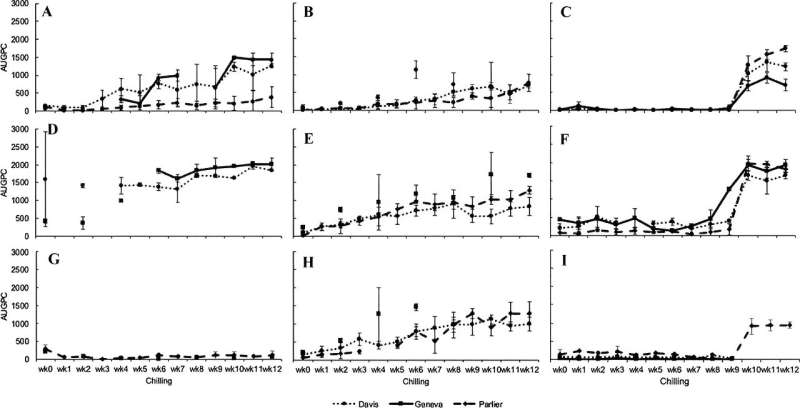This article has been reviewed according to Science X's editorial process and policies. Editors have highlighted the following attributes while ensuring the content's credibility:
fact-checked
peer-reviewed publication
trusted source
proofread
Cold stratification impacts germination rates in Vitis species

It is imperative for the success of the grape industry to develop new grape varieties capable of enduring shifting climates and heightened pressures from diseases and insects. The majority of grape cultivars rely on a specific amount of "chilling hours"' to complete dormancy for optimal growth and yield.
However, what occurs when a region experiences a decrease in chilling hours? Is it feasible to expedite the breeding process to produce vines with reduced chilling requirements? The USDA ARS table grape breeding program has collaborated with the USDA ARS National Clonal Germplasm Repository and Cornell University's fruit crop physiology and climate adaptation program to investigate the impact of environmental factors and chilling on seed dormancy and answer these crucial questions.
Dormancy, a state of reduced metabolic activity, is an important phenomenon in plants regulated by external (eco-dormancy) or internal (endo-dormancy) factors. Endo-dormancy in perennial plants, including seeds, controls germination timing and species distribution. Environmental conditions influence it during seed development and genetic factors. While seed dormancy mechanisms are well-studied in annual plants like Arabidopsis, less is understood about their impact on perennial species.
The study investigated the relationship between genetic factors and environmental conditions in the germination process of various Vitis species. The team analyzed the germination rates and cold stratification requirements of different cultivars under varying maternal plant environments. Significant variations in cold stratification requirements among different Vitis cultivars were identified.
Certain cultivars exhibited higher germination rates following specific durations of cold stratification, highlighting the importance of tailoring stratification protocols to individual cultivars.
Maternal plant environment(genetics and age of the plant) was found to exert a considerable influence on the germination behavior of Vitis species. Factors such as temperature, soil composition, and nutrient availability during seed maturation were found to impact seed dormancy and subsequent germination rates directly.
The findings have significant implications for grape breeding programs, as well as for vineyard management practices. By understanding the specific germination requirements of different cultivars, growers can optimize their seedling production processes and improve overall vineyard establishment.
The study also highlights the importance of conservation efforts for Vitis species, many of which are valued for their genetic diversity and potential for use in breeding programs. By understanding the factors that influence seed germination, researchers can better inform conservation strategies aimed at preserving these valuable genetic resources.
As the viticulture industry continues to face challenges such as climate change and emerging pests and diseases, this study can provide valuable insights that can help ensure the long-term sustainability and success of grape production worldwide.
The research is published in the journal HortScience.
More information: Safa A. Alzohairy et al, Cultivar and Maternal Plant Environment Influence Cold Stratification Requirements and Germination Rates of Vitis Species, HortScience (2023). DOI: 10.21273/HORTSCI17002-22
Journal information: HortScience
Provided by American Society for Horticultural Science





















